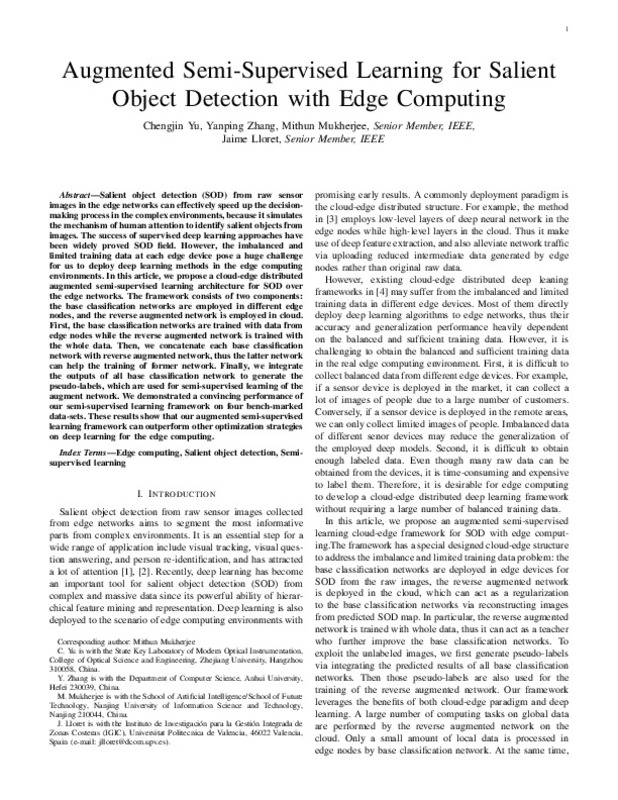JavaScript is disabled for your browser. Some features of this site may not work without it.
Buscar en RiuNet
Listar
Mi cuenta
Estadísticas
Ayuda RiuNet
Admin. UPV
Augmented semi-supervised learning for salient object detection with edge computing
Mostrar el registro sencillo del ítem
Ficheros en el ítem
| dc.contributor.author | Yu, Chengjin
|
es_ES |
| dc.contributor.author | Zhang, Yanping
|
es_ES |
| dc.contributor.author | Mukherjee, Mithun
|
es_ES |
| dc.contributor.author | Lloret, Jaime
|
es_ES |
| dc.date.accessioned | 2024-01-12T19:01:39Z | |
| dc.date.available | 2024-01-12T19:01:39Z | |
| dc.date.issued | 2022-06 | es_ES |
| dc.identifier.issn | 1536-1284 | es_ES |
| dc.identifier.uri | http://hdl.handle.net/10251/201884 | |
| dc.description.abstract | [EN] Salient object detection (SOD) from raw sensor images in the edge networks can effectively speed up the decision-making process in the complex environments, because it simulates the mechanism of human attention to identify salient objects from images. The success of supervised deep learning approaches have been widely proved SOD field. However, the imbalanced and limited training data at each edge device pose a huge challenge for us to deploy deep learning methods in the edge computing environments. In this article, we propose a cloud-edge distributed augmented semi-supervised learning architecture for SOD over the edge networks. The framework consists of two components: the base classification networks are employed in different edge nodes, and the reverse augmented network is employed in cloud. First, the base classification networks are trained with data from edge nodes while the reverse augmented network is trained with the whole data. Then, we concatenate each base classification network with reverse augmented network, thus the latter network can help the training of former network. Finally, we integrate the outputs of all base classification network to generate the pseudo-labels, which are used for semi-supervised learning of the augment network. We demonstrated a convincing performance of our semi-supervised learning framework on four bench-marked data-sets. These results show that our augmented semi-supervised learning framework can outperform other optimization strategies on deep learning for the edge computing. | es_ES |
| dc.language | Inglés | es_ES |
| dc.publisher | Institute of Electrical and Electronics Engineers | es_ES |
| dc.relation.ispartof | IEEE Wireless Communications | es_ES |
| dc.rights | Reserva de todos los derechos | es_ES |
| dc.subject | Edge computing | es_ES |
| dc.subject | Salient object detection | es_ES |
| dc.subject | Semisupervised learning | es_ES |
| dc.subject | Semi-supervised learning | es_ES |
| dc.subject | SOD | es_ES |
| dc.subject | IOT | es_ES |
| dc.subject.classification | INGENIERÍA TELEMÁTICA | es_ES |
| dc.title | Augmented semi-supervised learning for salient object detection with edge computing | es_ES |
| dc.type | Artículo | es_ES |
| dc.identifier.doi | 10.1109/MWC.2020.2000351 | es_ES |
| dc.rights.accessRights | Abierto | es_ES |
| dc.contributor.affiliation | Universitat Politècnica de València. Escuela Politécnica Superior de Gandia - Escola Politècnica Superior de Gandia | es_ES |
| dc.description.bibliographicCitation | Yu, C.; Zhang, Y.; Mukherjee, M.; Lloret, J. (2022). Augmented semi-supervised learning for salient object detection with edge computing. IEEE Wireless Communications. 29(3):109-114. https://doi.org/10.1109/MWC.2020.2000351 | es_ES |
| dc.description.accrualMethod | S | es_ES |
| dc.relation.publisherversion | https://doi.org/10.1109/MWC.2020.2000351 | es_ES |
| dc.description.upvformatpinicio | 109 | es_ES |
| dc.description.upvformatpfin | 114 | es_ES |
| dc.type.version | info:eu-repo/semantics/publishedVersion | es_ES |
| dc.description.volume | 29 | es_ES |
| dc.description.issue | 3 | es_ES |
| dc.relation.pasarela | S\506755 | es_ES |







![[Cerrado]](/themes/UPV/images/candado.png)

